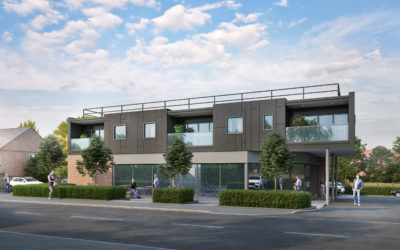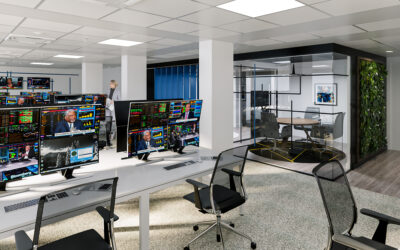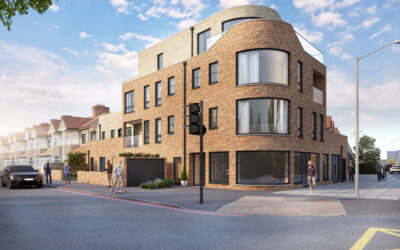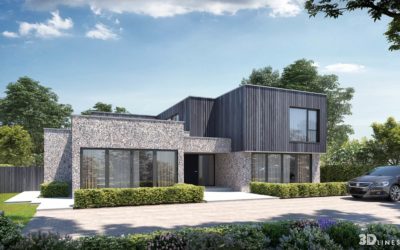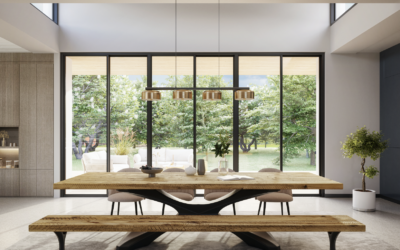3D Rendering Near Me: What Is It and How Does It Work?
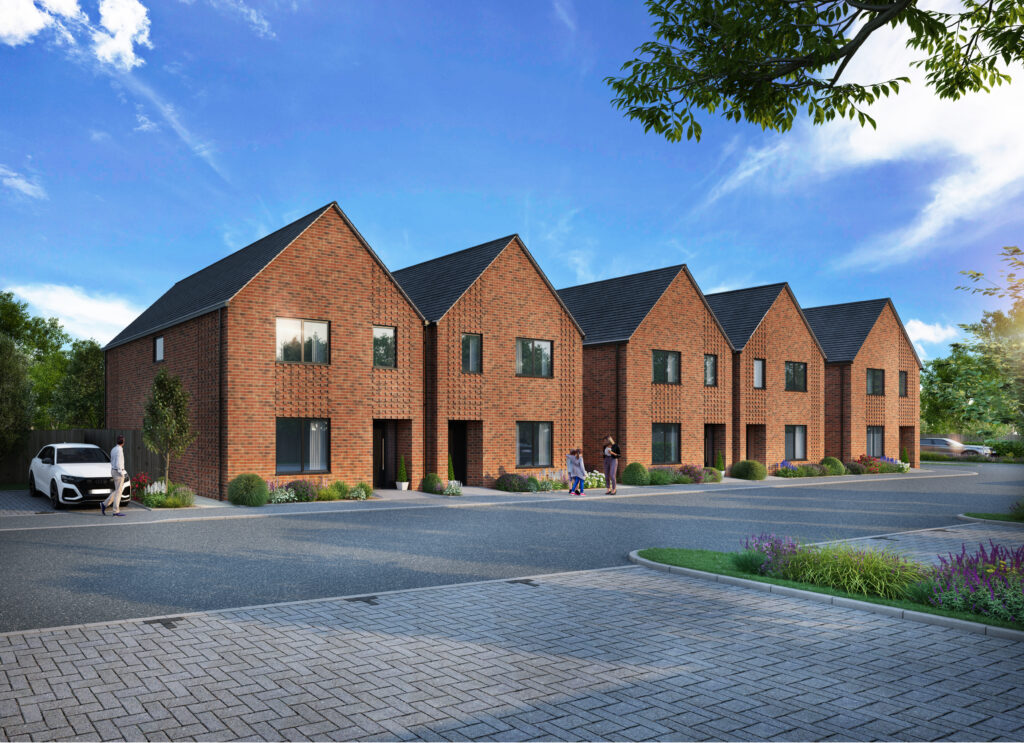
These days, as you casually browse your favourite magazines, skim through your social media feed, or take a drive around town, it’s quite likely you’ve laid eyes on the magic of a 3D render.
But you may wonder, what’s behind this visual sorcery known as 3D rendering? How did it swiftly carve its niche and evolve into a pivotal force across numerous sectors? As we delve deeper into this article, we’ll embark on an exploration of the captivating realm of 3D rendering and furnish you with tips to identify the crème de la crème of rendering specialists tailored for your needs.
What exactly is 3D rendering?
In simple terms, 3D rendering is akin to a painter’s final brushstroke that brings a canvas to life. It is the art and science of conjuring hyper-realistic 2D portrayals from intricate 3D models. It’s the crescendo in a sequence of steps in 3D visualization: sculpting diverse models, draping them with lifelike textures, and casting the perfect light to set the ambience. The mission? To craft an image that mirrors reality.
How Does 3D Rendering Work?
The process begins with the rendering engine performing many calculations based on predefined algorithms. Based on the mathematical data of the models and scenes the render artist has created in the program, they are processed gradually and then transformed into flat images.
During the processing stage, these models acquire colours, shadows, shades, and reflections due to the location and physics of other objects in the scene. As a result, their appearance becomes whole and complete, and every pixel of the image becomes more refined.
What Are 3D Rendering Techniques?
The concept of 3D rendering is identical to photography. During the 3D rendering, a rendering program utilises a camera and points it toward an object to compose or create a photo. After, digital lighting makes the render as detailed as possible, resulting in hyper-realistic images.
Rendering companies employ different techniques to create an effective 3D render that replicates how lights hit objects in real life. Some of these techniques include:
Real-Time Rendering
This is the most common rendering technique used in gaming and interactive graphics. These images are processed from 3D data at high speed, ensuring the rapid image processing necessary for video games, moving at least 60 frames per second.
Rasterisation
Rasterisation is one of the first methods used for 3D rendering.
In 3D rendering, think of a ‘mesh’ as a detailed jigsaw puzzle. This mesh is a collection of points, called ‘vertices,’ which join together to define the 3D object’s form and structure. Each vertex acts as a pivotal anchor, and when they link up, they form the polygons (often triangles or quadrilaterals) that give the object its tangible form and volume.
Thus, by manipulating these vertices and adjusting the polygons, artists and engineers can sculpt, modify, and perfect the representation of the 3D object in the digital space before it’s rendered into a realistic image.
As mentioned earlier, 3D rendering is like photography. In that sense, think of rasterisation as being similar to “Paint by Numbers,” meaning there’s an outline for every colour you paint. This 3D rendering method is known for its speed and is still commonly used for real-time rendering of different types of simulation, like computer games.
Ray Casting
When you hear the term “ray casting,” think of it as a spotlight shining onto a stage from the audience’s perspective. Ray casting is a technique used to craft 3D renders, where rays are projected onto the model starting from the vantage point of the camera. These rays, as they shine onto the model, capture information that is then utilized to generate a 3D projection, mapping out the scene from the camera’s unique perspective.
One of the standout attributes of ray casting is its speed. This agility enables artists to nimbly experiment with and adjust various light sources within the 3D environment, allowing for creative flexibility and quicker visual feedback. It serves as a bridge between the artist’s vision and the eventual lifelike depiction of the scene.
Ray Tracing
Another technique used for 3D rendering is ray tracking. Here, shadows, refractions, and reflections are stimulated. This process is similar to ray casting; the only difference is that ray tracing depicts light better as primary rays from the camera’s point of view are cast onto the 3D model to create secondary rays. After making contact with the model, reflection rays, shadow rays, and refraction rays are emitted.
Perspective Projection
Perspective projection makes far-away models look smaller than models closer to the viewer’s point of view. The rendering software creates perspective projections by multiplying a “dilation constant” to place models relative to the wanted size into the scene.
What Are Common Applications of 3D Rendering?
After exploring the techniques used in 3D rendering, it’s time to dive into the possibilities of 3D rendering. The application of this technique is vast as it encompasses different industries.
Architectural Renderings
Architectural renderings talk about the process of creating visual representations of architectural designs using computer-generated images or CGI techniques. These renderings communicate the interned feel, functionality, and look of a property before it’s constructed. They serve as powerful tools to bridge the gap between reality and imagination, allowing stakeholders to visualise architectural designs in a more immersive and tangible manner.
Product Renderings
Product renderings are necessary for showcasing products and highlighting their features before they’re actually manufactured. Thanks to 3D renderings, businesses can present their product designs in a photorealistic and compelling manner.
Beyond merely highlighting a product’s features, 3D renderings offer a vivid depiction of its materials, textures, and hues. This visualization empowers manufacturers to gauge not only the aesthetic allure but also the product’s practicality and user-friendliness.
Product renderings have found their foothold in diverse avenues like product catalogues, marketing drives, and digital shopping platforms, acting as a magnet to draw in consumers. Adopting this technology is both cost-saving and time-efficient. It paves the way for hyper-realistic product depictions, reducing the dependency on tangible prototypes in the preliminary phases of product creation.
Visual Effects in Animations and Movies
3D renderings have become the heart of the animation and movie industry as they enable the creation of seemingly impossible and breathtaking scenes. From awe-inspiring environments to mind-bending action scenes, 3D renderings turn imaginary worlds into reality.
Visual effect artists maximise advanced rendering techniques to create natural phenomena and physics and integrate CGI into live-action footage. This process creates a seamless blend of imagination and reality that captivates audiences and erases the limits of storytelling.
Virtual Reality and Gaming
Virtual Reality and gaming rely on 3D renderings to create highly immersive experiences.
In the realm of Virtual Reality (VR), 3D rendering techniques weave together immersive, interactive virtual scenarios. These scenarios invite users to engage with and traverse diverse digital landscapes as if they were tangible and happening in real time.
Conversely, the world of video games taps into 3D rendering to breathe life into remarkably realistic characters, weave spellbinding visual tales, and sculpt vast, detailed terrains. Thanks to the prowess of real-time rendering engines, games today can deliver fluid, adaptive visuals. This progression elevates the gaming experience, enveloping players in an almost palpable virtual embrace.
What Are the Benefits of 3D Rendering?
When executed with accuracy, 3D rendering unfurls a tapestry of advantages. A few notable ones include:
Perfect Lighting Every Time
3D rendering gives you complete control over indoor and outdoor lighting. Harnessing the power of 3D rendering means bidding adieu to the whims of Mother Nature. Gone are the days of patiently waiting for that golden hour, the perfect sunrise, or a clear sky to showcase architecture or landscapes in their best light.
3D rendering puts the reins in your hands. Whether you desire the soft glow of dawn, the dramatic shadows of dusk, or the bright midday sun, you can customize it all. You dictate the time, position the sun just right, and even modulate the sunlight’s brightness to capture your vision flawlessly in an image. The world truly becomes your canvas. It’s always a sunny day in 3D rendering!
For interiors, 3D rendering gives you control of every aspect of indoor lighting without paying for an expensive lighting crew. You can brighten or dim the light, sharpen or soften the shadows, and even bring the sunlight through the curtains.
Visualising Future Projects
Projects that are still on the planning page or unfinished are great opportunities for 3D rendering. Architects, builders, and other professionals can use 3D renders to explore options without the need to spend time and money on props, furniture, travel, and interior designers.
Additionally, as structures and spaces undergo changes, 3D renderings will save you the resources from starting over. You can easily iterate and modify 3D renders with ease and less expense than digital photographs.
Precise Measurements and Stunning Accuracy
One of the biggest benefits of 3D rendering is the ability to control different aspects of the image. This control is evident in different industries, but most especially in architectural renderings. Unlike digital photographs that can’t convert precise 3D distance information, 3D renderings offer precise measurements within the rendering itself.
For instance, imagine you have a 3D render of a large bedroom. Besides giving you the basic measurements of the ceiling height, 3D renderings will also provide sophisticated dimensions, like the height and width of each window in the room and the distance between two pieces of furniture. You can even rotate pieces in the room to get a more direct visual representation of distances, which are hidden when viewed from a static photograph.
3D Rendering Specialists: What You Need to Know When Choosing One
3D rendering is a skill that requires years to perfect, so choose a company that’s well-established and is up for the job. Consider the following when choosing a company to ensure the highest quality of your next 3D rendering project:
Reviews and Testimonials
Check online for reviews and testimonials of companies to see feedback from clients in terms of their quality, mode of communication, and timeliness. Leverage reviews and testimonials as a window into understanding the credibility of the company you’re considering partnering with.
Experience Matters
It’s advisable to engage with a company that not only specializes in 3D rendering but also boasts a rich history in the field. Inquire about the number of projects they’ve handled that align with your requirements as a testament to their expertise and proficiency. Most of the time, experience leads to quality work — a company that has provided 3D rendering services for years often exhibits the highest standards.
Quotes
Reach out to at least three rendering companies and ask for written quotes for your project. Get all the information in terms of pricing, timeline, materials, and scope of work to determine which company best fits your needs. However, avoid going with the lowest bid, as this doesn’t always guarantee the best quality or end result.
Processes
What is the company’s 3D rendering process? What techniques do they use? Do they adhere to the industry’s best practices? Make sure you have answers to these questions because these demonstrate a company’s professionalism and ability to get the job done.
Work Samples
Reputable companies are confident in showing you photos and videos of previous projects that involve 3D rendering. Always ask for work samples to help you evaluate the quality of the company’s work, as well as their work ethics and style.
Gut Feeling
Does the company’s staff make you feel comfortable? Is the company proactive in offering insights to help you navigate the complexities of the 3D rendering process? Effective communication is paramount. Choose a partner who not only responds promptly to your queries but also converses in a manner that feels genuine and friendly. You should always feel like you’re in a conversation with a trusted ally.
Hire a 3D Rendering Company Near Me: 3D Rendering by 3D Lines
We at 3D Lines possess a high level of competence with all types of 3D rendering work. We have years of experience providing 3D rendering services to clients in and around Bedford.
3D Lines upholds the highest standards possible when providing 3D rendering services to clients. Driven by results and fueled by innovation, we don’t just stop at understanding our clients’ requirements; we dive deep into their vision. For us, every 3D rendering project isn’t just a task; it’s a commitment. We’re not satisfied with just meeting deadlines; we strive to surpass our clients’ expectations, always pushing the boundaries and consistently going beyond the call of duty.
Interested in learning why we’re the number one choice of our clients in 3D rendering? Contact us today, and let’s talk about how our services can make your project stand out!
To Wrap Up
To sum everything up, 3D rendering is the art of creating unique and lifelike graphic elements, transforming the field of design, interior, architecture, construction, and many others. It’s slowly revolutionising the lives of both brands and consumers. Better e-commerce images can lead to higher levels of customer satisfaction, while brands can maximise 3D renderings for cost savings.
When conveying intricate visual details becomes a challenge, especially on a budget, it might be time to pivot and seek expert intervention. Consider collaborating with professionals and diving into the realm of 3D rendering services. 3D renderings stand out as a stellar medium to highlight your projects and prowess. Not only do they paint a vivid picture, but they also curate an unparalleled experience for your audience, making your vision both accessible and captivating.
